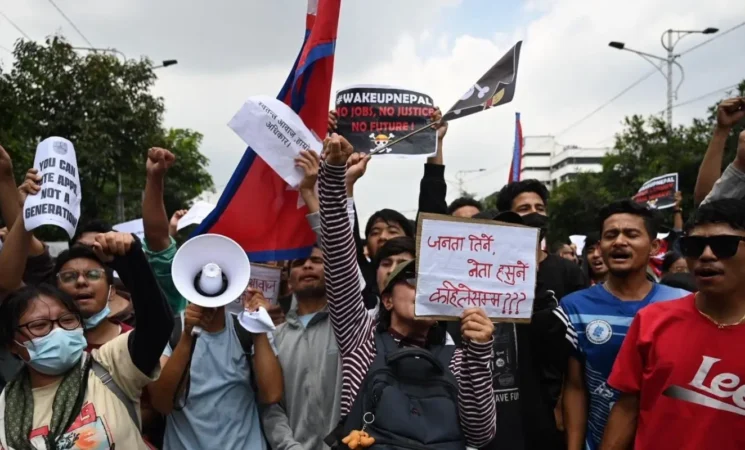14 September 2024, NIICE Commentary 11730
Ruby Khadgi
In September 2025, Nepal’s streets became the epicentre of South Asia’s latest democratic crisis. A youth-led anti-corruption movement forced the resignation of Prime Minister K.P. Sharma Oli, leaving former Chief Justice Sushila Karki to lead a caretaker administration. The unrest—fuelled by frustration with corruption, unemployment, elite impunity and digital mobilisation—was the most violent confrontation of Nepal’s republican era.
Nepal’s crisis reflects a wider regional trend. Across Asia, discontent is erupting in strikingly similar ways. In the Philippines, thousands rallied this month against systemic corruption. In Indonesia, unresolved rivalries among elites have repeatedly turned protests into mass riots. Nepal’s turmoil is part of a wider regional pattern: a generation demanding accountability from states that have promised democracy but delivered disillusionment.
Geopolitical realignments
Nepal occupies a pivotal position in South Asian geopolitics, situated at the intersection of Indian and Chinese spheres of influence. India continues to exercise cultural, economic and people-to-people leverage, while China has expanded its presence through large-scale investments in infrastructure, hydropower and connectivity under the Belt and Road Initiative. Periods of political instability in Kathmandu create opportunities for both powers to consolidate influence, thereby intensifying strategic competition. Shifts in Nepal’s foreign policy orientation are not confined to bilateral dynamics but reverberate across South Asia’s broader balance of power. A credible reform agenda under the interim government could help stabilise policy trajectories and reassure external stakeholders; conversely, prolonged uncertainty risks deeper oscillation between India and China, with adverse implications for trade corridors, border management and regional disaster-response mechanisms.
Democratic fragility and youth discontent
Nepal became a republic in 2008, yet frequent coalition collapses, corruption scandals, and uneven service delivery have steadily eroded public trust in democratic institutions. The current uprising is notable for both its social base and its methods: it is digitally networked, predominantly urban, and explicitly framed around anti-corruption demands. The interim leadership has acknowledged that the crisis reflects failures to deliver on constitutional promises of good governance and prosperity, underscoring the urgency of transparency and employment generation. Demography intensifies these pressures. With youth unemployment persistently high—estimated at around 20–21 per cent in 2024 (World Bank)—and more than half of the population under the age of 30, continued exclusion risks normalising contentious politics as a legitimate pathway to change. This wave of mobilisation echoes Sri Lanka’s 2022 protests, Bangladesh’s student movements, and current demonstrations in the Philippines. As in Indonesia, elite competition has amplified unrest rather than resolved it (Indonesia at Melbourne). What connects these cases is a collapse of trust: young people no longer believe leaders can deliver justice without being forced to act.
Impact on regional stability
Instability in Nepal seldom remains contained. Cross-border kinship networks, open or semi-porous frontiers, and integrated supply chains transmit shocks quickly. Two pathways are particularly salient:
Labour migration and remittances. Remittances constitute a critical economic lifeline for Nepal, reaching record levels in the most recent fiscal year and underscoring the scale of overseas employment. Episodes of political instability threaten to disrupt recruitment channels, drive workers into irregular migration pathways, and strain consular protection mechanisms across major destination countries such as the Gulf states, Malaysia and others. Given that Nepali labour is integral to construction, agriculture and care sectors across South Asia, the consequences of such disruptions would extend beyond national boundaries, generating regional spillovers with significant economic and social implications.
Border management and economic linkages. Governance slowdowns, whether due to cabinet churn, civil-service paralysis or social unrest, impede the maintenance of trade facilitation, customs modernisation and critical infrastructure. For both India and China, these dynamics increase costs and risks along key north–south and east–west corridors, while simultaneously complicating disaster-response logistics in the climate-vulnerable Himalayan region.
Why the world should care
Climate and water security. The Himalayan region—often described as the “Third Pole”—holds immense ice reserves that nourish river systems sustaining over a billion people (UNEP). In Nepal, weak governance and corruption in infrastructure projects heighten the risk that climate stresses, such as the record-low snow cover observed in 2024–25, will escalate into systemic disasters. Building resilient state capacity in this sphere is therefore not only a national imperative but also a matter of environmental security for the wider Asian region.
Migration, markets and supply chains. Nepal’s overseas labour force is deeply embedded in regional and global value chains. Governance shocks that disrupt migration flows reverberate far beyond its borders, influencing wages, project timelines and service provision across Asia and the Middle East. Because remittances form the backbone of household consumption and contribute substantially to foreign-exchange reserves, any abrupt decline would contract fiscal space and restrict imports. Such outcomes would magnify macroeconomic fragility across interconnected regional markets.
Democratic precedent. A democratic reversal in Nepal would signal a troubling precedent for other fragile or transitional democracies in South Asia. Historically, Nepal has attempted to balance external influence while pursuing democratic consolidation, a dynamic closely observed by regional actors. Should corruption and elite capture overwhelm accountability mechanisms, it may embolden illiberal leaders elsewhere to justify dismantling constitutional safeguards in the name of ‘stability’. Conversely, a credible reform process—anchored in electoral clarity, rule-of-law enhancements, expanded social protection and youth employment—could demonstrate that democratic resilience is possible even under severe strain.
Policy priorities
To contain the crisis and mitigate regional spillovers, four priorities merit urgent attention:
Accountability and reform sequencing must come first. An inquiry into protest-related violence should be transparent, time-bound, and victim-centred, while complementary reforms—such as mandatory asset declarations, stronger procurement oversight, and the digitalization of governance—would help reduce corruption and rebuild public trust. Youth employment is equally critical. Expanding apprenticeships, climate-resilient public works and credit support for micro, small and medium enterprises would help absorb a frustrated labour force. Aligning training pipelines with domestic industries and safer overseas placements could also reduce reliance on irregular migration (World Bank).
Building climate-resilient capacity must also be prioritised. Strengthening hydrometeorological services, promoting basin-level cooperation, and investing in community-based disaster risk reduction are essential. Climate-proofing critical border infrastructure would further secure trade and humanitarian corridors (UNEP).
Finally, Nepal should pursue a strategy of balanced external engagement. Transparent, viability-tested partnerships with India, China and multilateral institutions, while avoiding projects that jeopardise fiscal sustainability or sovereignty. Regional forums can play a constructive role by supporting Nepal’s electoral integrity, anti-corruption mechanisms and climate adaptation efforts, thereby reducing zero-sum competition.
Conclusion
Nepal’s current crisis is far from a parochial matter. It represents the convergence of youth-led frustration, institutional fragility, climate vulnerability and geopolitical rivalry. For South Asia, the stakes are stability, economic connectivity and the survival of democratic norms. For the wider international community, they include the security of Himalayan water resources, the continuity of global labour supply chains, and the credibility of the rules-based order. In essence, a fragile Nepal translates into a fragile South Asia and by extension, a more uncertain global environment.
Ruby Khadgi is a final-year postgraduate at Victoria University, undertaking studies required by the Victorian Legal Admissions Board (VLAB).
The views expressed here are the author's personal views.

